battery Alfa Romeo GT 2010 Owner handbook (in English)
[x] Cancel search | Manufacturer: ALFA ROMEO, Model Year: 2010, Model line: GT, Model: Alfa Romeo GT 2010Pages: 271, PDF Size: 5.34 MB
Page 177 of 271

CORRECT USE OF THE CAR
175
For the electrical connection a 7 or 13 pole
12VDC connection must be used (CU-
NA/UNI and ISO/DIN standards) following
any reference instructions given by the car
Manufacturer and/or towing device Manu-
facturer.
Any electric brake should be supplied directly
by the battery through a cable with a cross-
section of no less than 2.5 mm
2. In addition
to the electrical branches, the car electric sys-
tem can only be connected to the supply ca-
ble for an electric brake and to the cable for
an internal light, though not above 15W.
INSTALLATION LAYOUT
(fig. 1)
The tow hook structure must be fas-
tened in the points shown by the sym-
bol
Øusing 4 M8 screws and 7 M10
screws.
The inner plate (2) should have a
minimum thickness of 6 mm.
The inner plate (3) should have a
minimum thickness of 4 mm.
The inner plate (4) should have a
minimum thickness of 5 mm.
The fastening points (1) should be fit-
ted with 25 mm x 6 mm spacers.After fitting, the fasten-
ing screw holes shall be
sealed to prevent exhaust
gas inlet.
IMPORTANTIt is compulsory to fasten
a label (plainly visible) of suitable size and
material with the following wording:
MAX LOAD ON BALL 60 kg.
Page 180 of 271
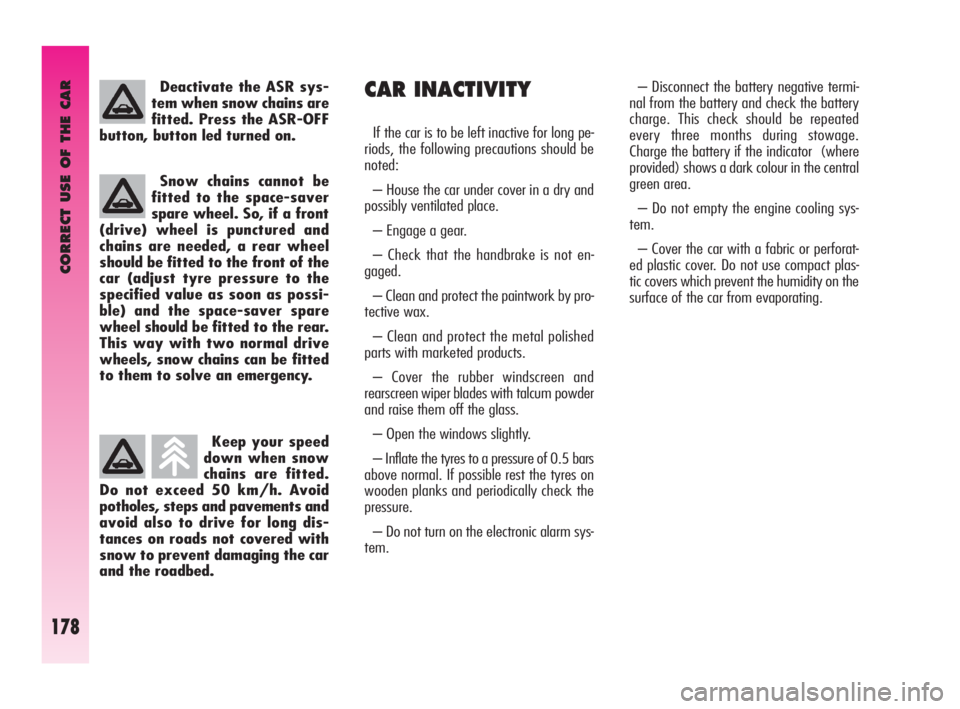
CORRECT USE OF THE CAR
178
Keep your speed
down when snow
chains are fitted.
Do not exceed 50 km/h. Avoid
potholes, steps and pavements and
avoid also to drive for long dis-
tances on roads not covered with
snow to prevent damaging the car
and the roadbed.
CAR INACTIVITY
If the car is to be left inactive for long pe-
riods, the following precautions should be
noted:
– House the car under cover in a dry and
possibly ventilated place.
– Engage a gear.
– Check that the handbrake is not en-
gaged.
– Clean and protect the paintwork by pro-
tective wax.
– Clean and protect the metal polished
parts with marketed products.
– Cover the rubber windscreen and
rearscreen wiper blades with talcum powder
and raise them off the glass.
– Open the windows slightly.
– Inflate the tyres to a pressure of 0.5 bars
above normal. If possible rest the tyres on
wooden planks and periodically check the
pressure.
– Do not turn on the electronic alarm sys-
tem.– Disconnect the battery negative termi-
nal from the battery and check the battery
charge. This check should be repeated
every three months during stowage.
Charge the battery if the indicator (where
provided) shows a dark colour in the central
green area.
– Do not empty the engine cooling sys-
tem.
– Cover the car with a fabric or perforat-
ed plastic cover. Do not use compact plas-
tic covers which prevent the humidity on the
surface of the car from evaporating. Snow chains cannot be
fitted to the space-saver
spare wheel. So, if a front
(drive) wheel is punctured and
chains are needed, a rear wheel
should be fitted to the front of the
car (adjust tyre pressure to the
specified value as soon as possi-
ble) and the space-saver spare
wheel should be fitted to the rear.
This way with two normal drive
wheels, snow chains can be fitted
to them to solve an emergency.
Deactivate the ASR sys-
tem when snow chains are
fitted. Press the ASR-OFF
button, button led turned on.
Page 182 of 271

IN AN EMERGENCY
180
STARTING
WITH AN AUXILIARY BATTERY
If the battery is flat (for battery with op-
tical hydrometer: dark colour without green
area in the centre), it is possible to start the
engine using an auxiliary battery with the
same capacity or a little higher than the flat
one.
Proceed as follows (fig. 1):
1) Remove the protective cover on the pos-
itive battery post pressing on the opening
catches (front), then connect the positive
terminals (+sign next to the terminal) of
the two batteries using a special cable.
2) Connect the end of the second jump
lead to the negative terminal (–) of the aux-
iliary battery with an earth point
Eon the
engine or gearbox of the car to be started.IMPORTANTDo not directly connect the
negative terminals of the two batteries: any
sparks may ignite the detonating gas which
could come out of the battery. If the auxil-
iary battery is installed on another car, avoid
metal parts touching accidentally between
this car and the one with the flat battery.
3) Start the engine.
4) When the engine has started, remove
the cables, reversing the sequence followed
for connection.
If after a few attempts the engine does not
start, do not insist but contact the nearest
Alfa Romeo Authorised Service.
fig. 1
A0A0149b
This starting procedure
must be carried out by
qualified personnel because
incorrect operations may cause
electrical discharge of considerable
intensity. The liquid contained in
the battery is poisonous and cor-
rosive. Avoid contact with the skin
and the eyes. Keep naked flames
and lighted cigarettes away from
the battery and do not cause
sparks.
Never use a battery
charger to start the engine
as this could damage the
electronic systems of your car, par-
ticularly the ignition and fuel sup-
ply control units.
Page 208 of 271
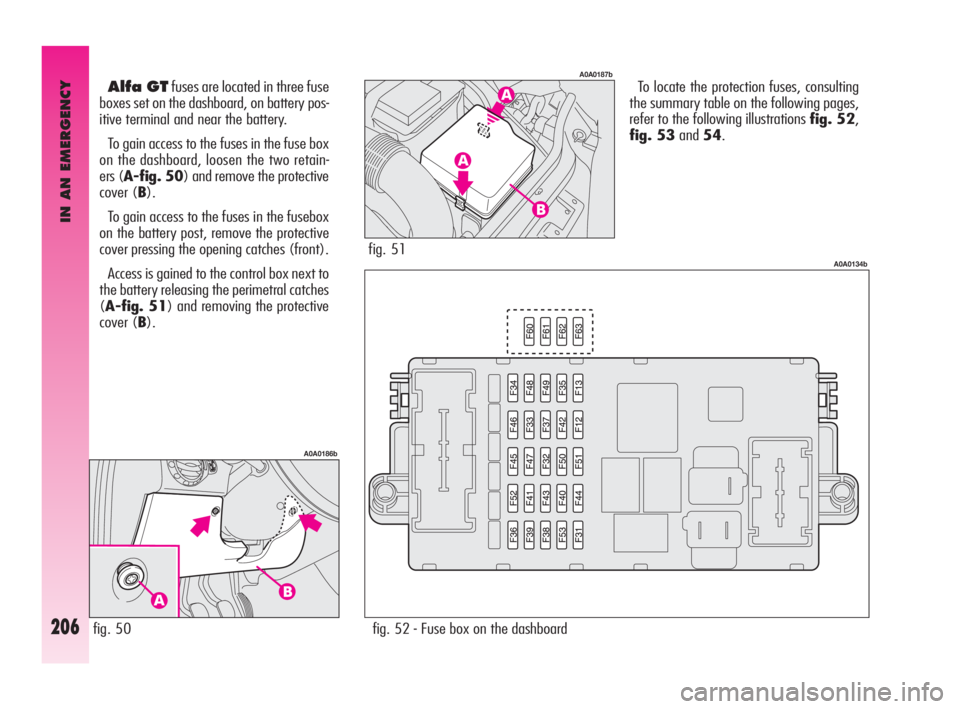
IN AN EMERGENCY
206
To locate the protection fuses, consulting
the summary table on the following pages,
refer to the following illustrations fig. 52,
fig. 53and54.Alfa GTfuses are located in three fuse
boxes set on the dashboard, on battery pos-
itive terminal and near the battery.
To gain access to the fuses in the fuse box
on the dashboard, loosen the two retain-
ers (A-fig. 50) and remove the protective
cover (B).
To gain access to the fuses in the fusebox
on the battery post, remove the protective
cover pressing the opening catches (front).
Access is gained to the control box next to
the battery releasing the perimetral catches
(A-fig. 51) and removing the protective
cover (B).
fig. 50
A0A0186b
fig. 51
A0A0187b
fig. 52 - Fuse box on the dashboard
A0A0134b
Page 209 of 271
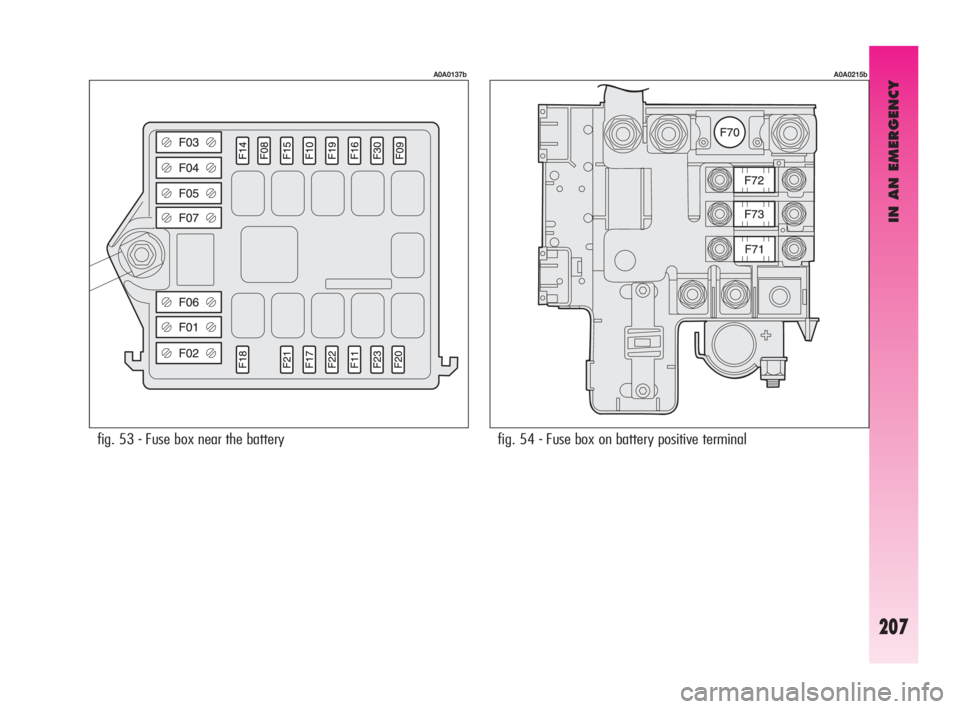
IN AN EMERGENCY
207
fig. 53 - Fuse box near the battery
A0A0137b
fig. 54 - Fuse box on battery positive terminal
A0A0215b
Page 214 of 271
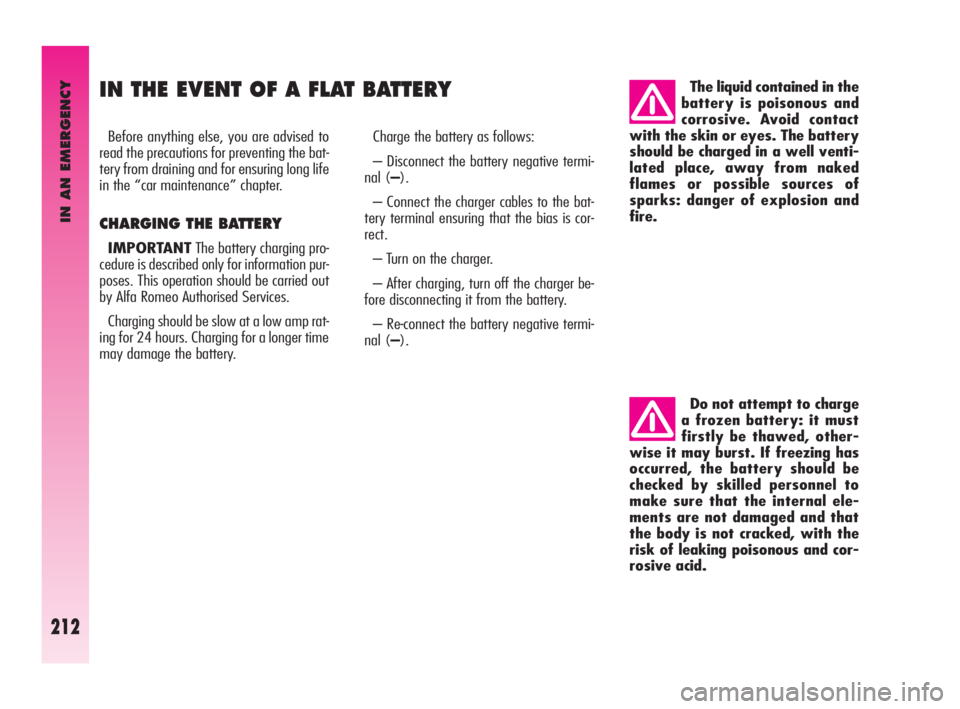
IN AN EMERGENCY
212
IN THE EVENT OF A FLAT BATTERY
Before anything else, you are advised to
read the precautions for preventing the bat-
tery from draining and for ensuring long life
in the “car maintenance” chapter.
CHARGING THE BATTERY
IMPORTANTThe battery charging pro-
cedure is described only for information pur-
poses. This operation should be carried out
by Alfa Romeo Authorised Services.
Charging should be slow at a low amp rat-
ing for 24 hours. Charging for a longer time
may damage the battery.Charge the battery as follows:
– Disconnect the battery negative termi-
nal (–).
– Connect the charger cables to the bat-
tery terminal ensuring that the bias is cor-
rect.
– Turn on the charger.
– After charging, turn off the charger be-
fore disconnecting it from the battery.
– Re-connect the battery negative termi-
nal (–).The liquid contained in the
battery is poisonous and
corrosive. Avoid contact
with the skin or eyes. The battery
should be charged in a well venti-
lated place, away from naked
flames or possible sources of
sparks: danger of explosion and
fire.
Do not attempt to charge
a frozen battery: it must
firstly be thawed, other-
wise it may burst. If freezing has
occurred, the battery should be
checked by skilled personnel to
make sure that the internal ele-
ments are not damaged and that
the body is not cracked, with the
risk of leaking poisonous and cor-
rosive acid.
Page 217 of 271

IN AN EMERGENCY
215
– In motorways pileups, especially with
poor visibility, the risk of being involved in
other crashes is high. Leave the car imme-
diately and go beyond the guard-rail.
– If doors are blocked, do not try to get
out of the car breaking the windscreen which
is stratified. The windows and rear screen
are easier to break.
– Remove the ignition key of the cars in-
volved.
– If you note a smell of fuel or other chem-
ical products, do not smoke and have a cig-
arette stubbed out.
– To put out fires, even small ones, use
the extinguisher, blankets, sand, or earth.
Never use water.
– If use of the lighting system is not nec-
essary, disconnect the battery negative ter-
minal (–).IN THE EVENT
OF AN ACCIDENT
– It is important to keep calm.
– If you are not directly involved, stop at
least a few dozen metres away from the ac-
cident.
– On motorways, stop without blocking
the emergency lane.
– Turn the engine off and the hazard warn-
ing lights on.
– At night, illuminate the place of the ac-
cident with the headlights.
– Take care, do not risk being run over.
– Signal the accident placing the triangle
at regulation distance in a clearly visible
place.
– Call the emergency organisation, giving
the most accurate information possible. On
motorways use the special phones provid-
ed.
IF PEOPLE ARE INJURED
– An injured person must never be aban-
doned. Helping is compulsory also for per-
sons not directly involved in the accident.
– Do not crowd around injured people.
– Reassure the injured person that help
is on the way, and stay near to overcome
any panic.
– Release or cut the seat belt restraining
injured persons.
– Do not give injured persons anything
to drink.
– An injured person should never be
moved except in the following circum-
stances.
– Remove an injured person from the car
only in danger of fire, sinking or falling.
When removing an injured person: do not
pull the limbs or bend the head and keep
the body as horizontal as possible.
FIRST AID KIT
In addition to the first-aid kit, it is also
wise to keep an extinguisher and a blan-
ket in the car.
Page 219 of 271

CAR MAINTENANCE
217
SCHEDULED MAINTENANCE PROGRAMME
20 40 60 80 100 120 140 160 180Thousands of km
Check tyre conditions/wear and adjust pressure if necessary
Check operation of lighting system (headlights, direction indicators,
hazard warning lights, boot, passenger compartment, glovebox lights, warning lights, etc..)
Check operation of windscreen washer system, adjust spray jets
Check position/wear of windscreen/rearscreen wiper blades
Check operation of front disk brake pad wear indicator
Check wear conditions of rear disk brake pads
Sight check the conditions of: body exterior, underbody protection, stiff pipes
and hoses (exhaust - fuel supply - brakes), rubber parts
(boots - sleeves - bushes etc..)
Check cleanness of locks, bonnet and boot and lever cleanness, and lubrication
Sight inspect accessory drive belt conditions
Check handbrake lever stroke adjustment
Change air cleaner cartridge (petrol versions)
Change air cleaner cartridge (JTD versions)
Top up fluid levels (engine coolant, brakes, windscreen washer, battery, etc..)
●●●●●●●●●
●●●●●●●●●
●●●●●●●●●
●●●●●●●●●
●●●●●●●●●
●●●●
●●●●●●●●●
●●●●●●●●●
●●
●●●●
●●●●
●●●●●●●●●
●●●●●●●●●
Page 221 of 271
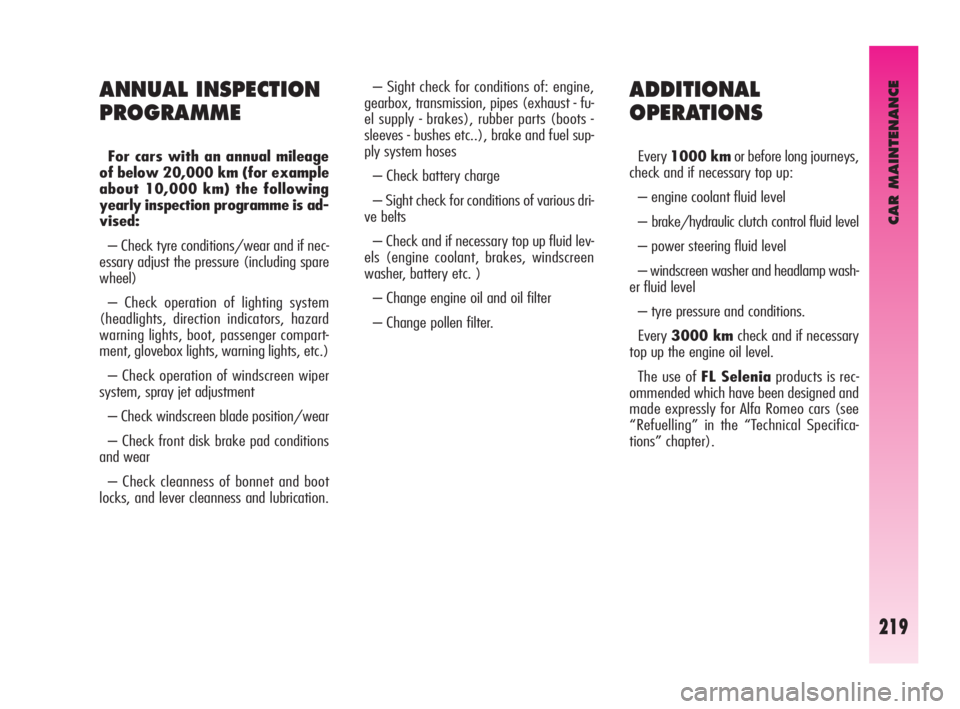
CAR MAINTENANCE
219
ADDITIONAL
OPERATIONS
Every 1000 kmor before long journeys,
check and if necessary top up:
– engine coolant fluid level
– brake/hydraulic clutch control fluid level
– power steering fluid level
– windscreen washer and headlamp wash-
er fluid level
– tyre pressure and conditions.
Every 3000 kmcheck and if necessary
top up the engine oil level.
The use of FL Seleniaproducts is rec-
ommended which have been designed and
made expressly for Alfa Romeo cars (see
“Refuelling” in the “Technical Specifica-
tions” chapter).
ANNUAL INSPECTION
PROGRAMME
For cars with an annual mileage
of below 20,000 km (for example
about 10,000 km) the following
yearly inspection programme is ad-
vised:
– Check tyre conditions/wear and if nec-
essary adjust the pressure (including spare
wheel)
– Check operation of lighting system
(headlights, direction indicators, hazard
warning lights, boot, passenger compart-
ment, glovebox lights, warning lights, etc.)
– Check operation of windscreen wiper
system, spray jet adjustment
– Check windscreen blade position/wear
– Check front disk brake pad conditions
and wear
– Check cleanness of bonnet and boot
locks, and lever cleanness and lubrication.– Sight check for conditions of: engine,
gearbox, transmission, pipes (exhaust - fu-
el supply - brakes), rubber parts (boots -
sleeves - bushes etc..), brake and fuel sup-
ply system hoses
– Check battery charge
– Sight check for conditions of various dri-
ve belts
– Check and if necessary top up fluid lev-
els (engine coolant, brakes, windscreen
washer, battery etc. )
– Change engine oil and oil filter
– Change pollen filter.
Page 223 of 271

CAR MAINTENANCE
221
Car maintenance should be
entrusted to Alfa Romeo
Authorised Services. For
routine and minor maintenance op-
erations you wish to carry out
yourself, always make sure you
have the proper equipment, genuine
Alfa Romeo spares and the neces-
sary fluids; do not however carry
out these operations if you have no
experience.IMPORTANT
Pollen filter
If the car is used frequently in dusty or
heavily polluted environments it is advisable
to replace the filtering element more fre-
quently; in particular it should be replaced if
a reduction of the amount of air admitted to
the passenger compartment is noted. IMPORTANT
Battery
It is advisable to check the battery charge,
preferably at the onset of winter, to prevent
the possibility of the electrolyte freezing.
This check should be carried out more fre-
quently if the car is used mainly for short
trips, or if it is fitted with accessories that
permanently absorb electricity even with the
ignition key removed, especially in the case
of after market accessories.
If the car is used in hot climates or partic-
ularly harsh conditions it is wise to check the
level of the battery fluid (electrolyte) more
frequently than specified in the Scheduled
Maintenance Programme.